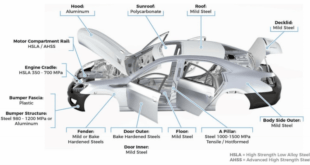In purely economic terms, methane leaks from well-heads and pipelines cost the oil and gas industry between $6bn and $30bn a year. In the US, methane leaks from the natural gas and petroleum industry are now the number one source of methane emissions, surpassing livestock digestion and landfill. Although it …
Read More »Cyber Security of Aircraft avionics on commercial and military aircrafts
Avionics are the electronic systems used on aircraft. Aircraft avionics is the most crucial component of aircraft systems and helps in providing various operational and virtual information in-flight and on the ground. The avionics system receives data from the air traffic management system and feeds this information to the pilot …
Read More »Active Flow control for Stealth Aircrafts and Drones
Combat aircraft have continued to evolve since the introduction of the jet engine during World War II, exemplified by the F-16, first flown in 1974, the F-22 (1990), and the F-35 (2001). These aircraft are characterized by a traditional wing/body/tail arrangement, are all commanded by an on-board pilot, and are …
Read More »Roll Out Solar Array (ROSA) are flexible and lightweight solar array being tested on Satellites
The solar cells produce electrical power (current) from incident sunlight. However, individual solar cells generate very little power. So, in order to generate more power, a group of cells that are present in an array form can be used. Solar arrays are primarily used in satellites in order to provide …
Read More »Future digitized Battlefield require Soldier transformation to software experts and data analysts
In an era where technology is the key driver enhancing capabilities across the military, the soldier remains as crucial as ever for achieving mission success. Some of the missions the soldiers perform can take weeks, away from in difficult terrain like deserts and mountains which requires maintaining an incredibly high …
Read More »Automated test and measurement (ATE) for lifesaving, mission-critical, and safety-critical electronics of Defense and Aerospace Systems
The aerospace and defense industry is one of the most massive, and multibillion-dollar industries in operation. This calls for the electronics and technology used in this industry need running at 100% efficiency level to make sure that the equipment doesn’t malfunction and get damaged or provide lower utility than it …
Read More »Automotive Lightweight Materials
Advanced materials are essential for boosting the fuel economy of modern automobiles while maintaining safety and performance. Because it takes less energy to accelerate a lighter object than a heavier one, lightweight materials offer great potential for increasing vehicle efficiency. A 10% reduction in vehicle weight can result in a …
Read More »Improved Lead-Acid Batteries including lead-crystal and carbon foam batteries making comeback
Virtually every modern naval weapons system, in fulfilling its mission, is highly dependent upon the performance characteristics of its electrochemical power supply. For example, batteries are used to power detection, guidance, control, ignition, propulsion, arming, fuzing, transmitting and jamming devices. The need for weapons with increased range, speed, endurance, sensitivity …
Read More »DARPA HACMS employed Formal Verification Methods to develop hack proof unmanned vehicles , weapons , satellites, and command and control systems
In 2011, Iran claimed to have downed a sophisticated American stealth drone, and unveiled what it alleged was a reverse-engineered copy of the futuristic looking RQ-170 Sentinel UAV, produced by defense giant Lockheed Martin. The drone was brought down by the Iranian Armed Forces’ electronic warfare unit which commandeered the …
Read More »DARPA project for cryogenic cables and connectors for quantum computing
Cryogenic electronics is important for a growing number of applications, including superconducting classical computing, superconducting quantum computing and quantum annealing, and superconducting single-photon detector arrays. One of the more difficult aspects about developing a successful superconducting electronics technology at very low temperatures (~10 mK) is the lack of robust commercial …
Read More » International Defense Security & Technology Your trusted Source for News, Research and Analysis
International Defense Security & Technology Your trusted Source for News, Research and Analysis










